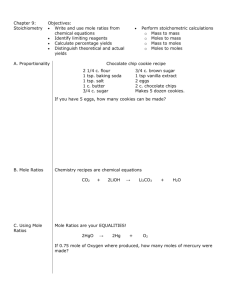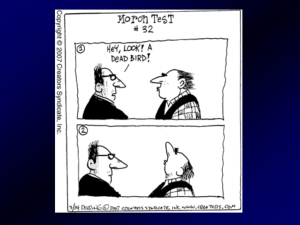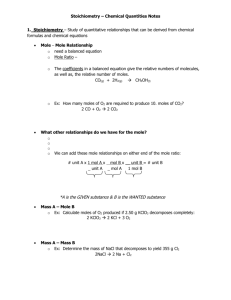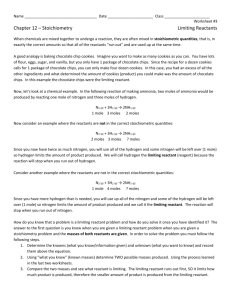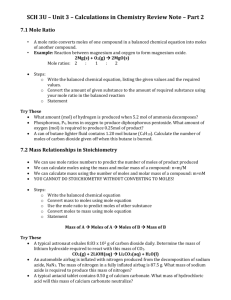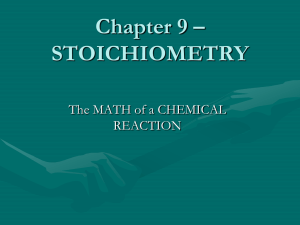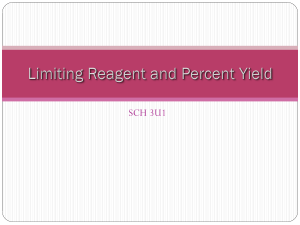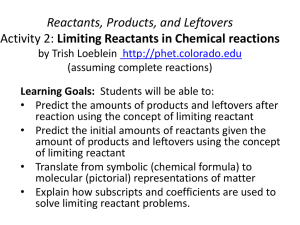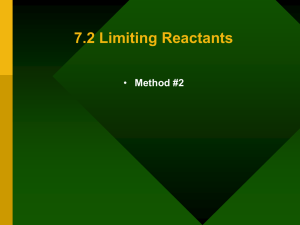you need to
advertisement
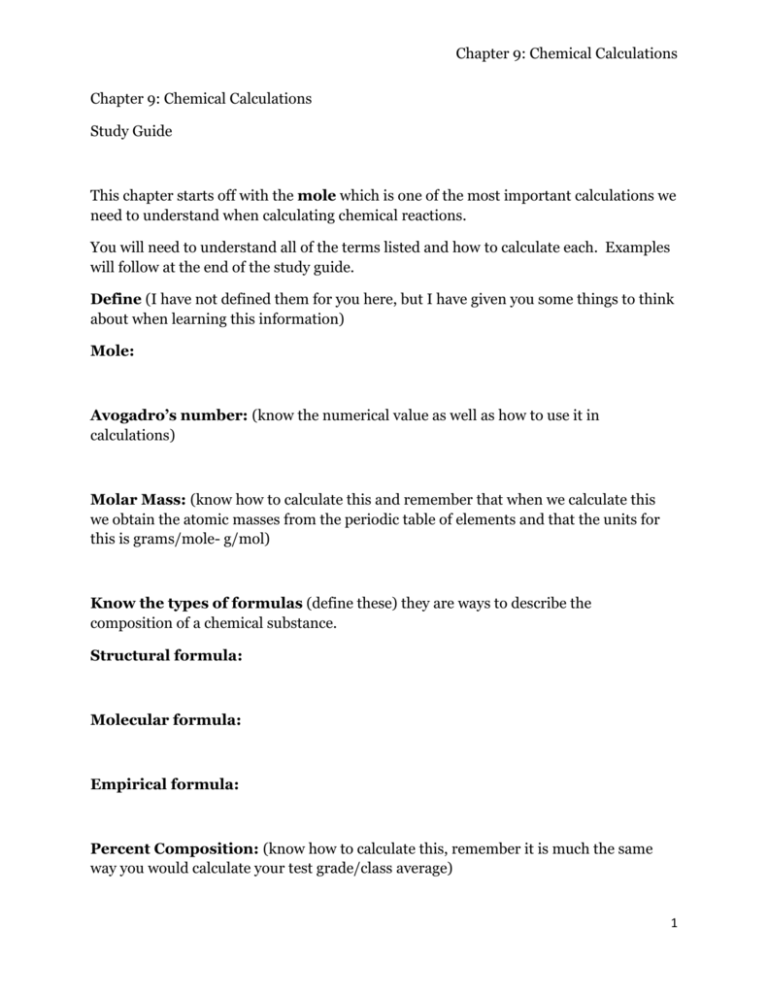
Chapter 9: Chemical Calculations Chapter 9: Chemical Calculations Study Guide This chapter starts off with the mole which is one of the most important calculations we need to understand when calculating chemical reactions. You will need to understand all of the terms listed and how to calculate each. Examples will follow at the end of the study guide. Define (I have not defined them for you here, but I have given you some things to think about when learning this information) Mole: Avogadro’s number: (know the numerical value as well as how to use it in calculations) Molar Mass: (know how to calculate this and remember that when we calculate this we obtain the atomic masses from the periodic table of elements and that the units for this is grams/mole- g/mol) Know the types of formulas (define these) they are ways to describe the composition of a chemical substance. Structural formula: Molecular formula: Empirical formula: Percent Composition: (know how to calculate this, remember it is much the same way you would calculate your test grade/class average) 1 Chapter 9: Chemical Calculations Stoichiometry: (I know this is a big weird word but it is really a very simple concept and is how we understand chemical reactions numerically) Mole ratios: (the definition states that these are ratios so they will be just that, also remember they require a balanced equation and we are focusing here on the coefficients) Limiting reactant: (this term is self defining, remember what part of the chemical equation are reactants and what part are the products, and limiting means that it is prohibiting something from occurring) Excess reactants: (again a self-defining word, chemistry is full of these self-defining terms, excess means too much and recall which part of the reaction are reactants) Percent yield: (more self defining terms, yield means how much of what is being made, how much you get out of your investment or in chemistry, your reaction, percent is a ration of something times 100) Theoretical yield: (self-defining?-Yep! Theoretical means what you think you ought to get, not what is really happening. Remember yield…) Actual yield: (yet again… self-defining. Actual means what is really there. Remember yield…) 2 Chapter 9: Chemical Calculations Formulas: Moles (n) = Molecular Mass (MM) x mass (m) given in problem Calculate the moles in 124.5g of oxygen gas. n = mass ÷ MM mass = 124.5g MM of O2 = 2 x 16.00 =32.00g mol-1 n = 124.5 ÷ 32.00 = 3.89mol Mass (m) = moles (n) ÷ Molecular Mass (MM) Calculate the mass of 0.25 moles of water mass (in grams) = n x MM n = 0.25mol MM of water (H2O) = (2 x 1.008) + 16.00 = 18.016g mol-1 mass = 0.25 x 18.016 = 4.504g Molecular Mass (MM) = mass (m) given ÷ moles (n) Calculate the molecular mass of a pure substance if 1.75 moles of the substance has a mass of 29.792g MM = mass ÷ n mass = 29.792g n = 1.75mol MM = 29.792 ÷ 1.75 = 17.024g mol-1 Mole ratios = number of atoms of 1st element: number of atoms in 2nd element: #atoms in 3rd element and so on… EX: H2O = 2:1 ratio of H to O C6H12O6= 1:2:1 ratio of C to H to O 3 Chapter 9: Chemical Calculations Limiting reactant = balanced equation here is a must A 2.00 g sample of ammonia is mixed with 4.00 g of oxygen. Which is the limiting reactant and how much excess reactant remains after the reaction has stopped? First, we need to create a balanced equation for the reaction: 4 NH3(g) + 5 O2(g) 4 NO(g) + 6 H2O(g) Next we can use stoichiometry to calculate how much product is produced by each reactant. NOTE: It does not matter which product is chosen, but the same product must be used for both reactants so that the amounts can be compared. The reactant that produces the lesser amount of product: in this case the oxygen. Excess Reactant: finish off the problem above Next, to find the amount of excess reactant, we must calculate how much of the nonlimiting reactant (oxygen) actually did react with the limiting reactant (ammonia). We're not finished yet though. 1.70 g is the amount of ammonia that reacted, not what is left over. To find the amount of excess reactant remaining, subtract the amount that reacted from the amount in the original sample. 4 Chapter 9: Chemical Calculations Percent Yield = [mass of created element (or compound) ÷ total mass of the molecule (compound)] x 100% Example: You burn 10.0 grams of methane in an excess of oxygen and form 19.8 grams of water. What was your percent yield? Solution : First, you need to find out how much product you would expect to make using basic stoichiometry. The reaction of methane with oxygen is shown below CH4(g) + 2O2(g) -> CO2(g) + 2H2O(g) You start with 10.0 grams of methane, which has a molecular weight of 16.04 g/mole, so you have 10.0 g/16.04 g/mole = 0.623 moles of methane. The ratio between methane and water is 2 water for every 1 methane, so you expect to form 0.623 moles CH4 * 2 moles H2O/1 mole CH4 1.25 moles H2O Now convert back to grams: the mole weight of water is 18.02 g/mole, so you should form 1.25 moles H2O * 18.02 g/mole = 22.5 g water if the reaction had gone perfectly. You only formed 19.8 however, so your percent yield is % yield = mass created/mass expected * 100% % yield = 19.8 g/22.5 g = 88.0% 5 Chapter 9: Chemical Calculations More Examples: Stoichiometry 1. A sample contains 27.1 g of calcium oxide. How many moles of calcium oxide are in the sample? NOTE: Use the Periodic Table to find the molecular mass (grams per mole) 2. How many atoms are in 0.652 mol of iron? NOTE: A mole is by definition 6.0220 x 1023 particles which can generally be rounded to 6.02 x 1023. 3. How many liters does 3.8 moles of O2 occupy at STP (standard temperature and pressure)? NOTE: At STP, 1 mole of any gas = 22.4L. STP is 273K (0 C) and 1 atm. 4. A solution of NaCl has a molarity of 0.549 M. How many moles are in 350. mL of this solution? NOTE: Molarity is MOLES per LITER. The volume in milliliters must be converted to Liters. 6 Chapter 9: Chemical Calculations 5. How many grams of sodium hydroxide are needed to make 250. mL of a 0.200 M solution? 6. How many grams of carbon dioxide are there in a container with a volume of 4.50L at STP? 7. How many moles of nitrogen are there in a 7.45 mol sample of ammonium phosphate? 8. If 120. g of propane, C3H8, is burned in excess oxygen, how many grams of water are formed? 7 Chapter 9: Chemical Calculations 9. 90.0 g of FeCl3 reacts with 52.0 g of H2S. What is the limiting reactant? What is the mass of HCl produced? What mass of excess reactant remains after the reaction? NOTE: The limiting reactant is the reactant that limits the amount of product that can be formed and is completely consumed during the reaction. The excess reactant is the reactant that is left over once the reaction has stopped due to the limiting reactant. 8

